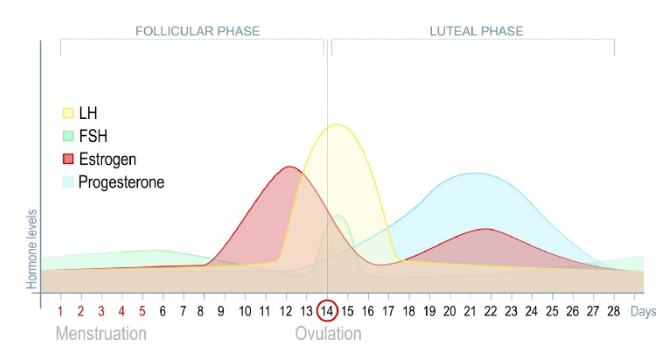6 Reasons Why Weight Loss is Harder For Women
Have you ever started a weight loss plan with your friends or boyfriend and realized that men see much faster results than women?
Or do you know any men who just control their diet and practically lose weight while sitting on the couch all day?
Frustrating, isn’t it?
So, why is it that women have to work much harder than men to shed those extra pounds? Why is is that weight loss for women is a nightmare, while it is a joy ride for men?
The answer is simple.
Men and women have different physiology and thus lose weight at different rates. Men, inherently, have a physiological advantage when it comes to weight loss.
For those of you who still think that it is a myth that weight loss for women is harder than it is for men, we have got proof for you. This recent study on weight loss and metabolic outcomes confirms that men lose weight faster than women.
It is true that weight loss for women is much harder. And here are some of the reasons why it is:
1. Monthly Estrogen Roller Coaster
One of the key reasons why women find it more difficult to lose weight is the monthly rollercoaster of surges and dips in hormones. Women’s estrogen and progesterone levels keep fluctuating throughout the month, depending on where they are in their monthly cycle.
To understand the varying hormonal levels and how they impact women’s bodies, we need to look at different phases of the monthly cycle:
Follicular Phase
This is the first half of the monthly cycle that includes the days when you are menstruating and the days immediately following that.
Both estrogen and progesterone levels are low at the start of this phase, but after menstruation, the estrogen level shoots up. Insulin sensitivity is also high during this phase so your blood sugar level is more balanced. The body requires more carbohydrates during this time and you can get away with eating a bit extra during this phase.
However, since the body goes through a lot during this time, only a light exercise routine needs to be followed in this phase.
Basically, you tend to eat more and exercise less during the first half of the follicular phase but can exercise more in the second half.
Luteal Phase
During this phase, the follicle that releases the egg starts to produce progesterone. So, the progesterone level remains high during this phase. Progesterone impairs insulin sensitivity and often cause blood sugar and insulin imbalances in the body.
These, in turn, cause a number of other symptoms like food cravings, bloating, mood swings and fatigue. All of these symptoms, individually and collectively, are detrimental to weight loss or any kind of workout program.
Also, the estrogen level again starts dropping in this phase and brings serotonin level down with it. Low serotonin levels are known to cause increased appetite, which, let’s face it, is not good for someone trying to stick to a strict diet and workout program.

Image Source: Paleo for Women
Overall Impact
If you are starting to get worried right now, wait, because I haven’t even started with the emotional side-effects of these hormonal dips and surges.
These hormonal changes also affect women emotionally and often cause mood swings, crankiness, cravings, etc.
Now imagine going through this emotional and physical rollercoaster and then trying to maintain a weight loss schedule.
Now when we talk about men, not only are they unaffected by their (not as drastic) hormonal changes, they actually benefit from the presence of high amounts of testosterone. Testosterone actually helps build muscle and get a leaner body.
When it comes to weight loss, women are inherently at a disadvantage because of a lack of testosterone and the side-effects caused by weekly hormonal changes.
2. Metabolism
Another difference between men and women, and their respective abilities to lose weight, comes from a difference in metabolic rates.
Men have higher metabolic rates than women and tend to burn calories faster. While the opposite is true for women.
Consequently, women burn less calories with the same amount and intensity of workout as men. Even if women follow the exact same diet plan as men, they will retain more fat than men.
Men’s metabolism is built for better speed, strength, and size and is more conducive to weight loss and muscle gain than women.
3. Social Stigmas
Research has shown that social stigmas related to obesity are detrimental to achieving and maintaining weight loss. According to a recent study, an increase in weight stigma experienced by an individual can reduce the likelihood of maintaining weight loss by as much as 28%.
And women reportedly face more social stigma and body shaming than men and they also handle it differently. According to a recent study, women who face weight stigma lose their motivation to workout, while it has the exact opposite effect on men.
Apart from the fact that women who face weight-related social stigma are less motivated to exercise, they also face emotional effects of that stigma.
Women who are body-shamed often develop body-image issues and low self-esteem, which cause depressive tendencies. Due to this, women tend to eat more to feel better, which leads to weight gain and more body-image issues. It is a vicious cycle and it is one that is not easy to break.
4. Physiological Factors
The differences in male and female physiology also affect the rates at which each lose weight. Men tend to have more muscle, which is easier to burn and, hence, results in more rapid weight loss. Women tend to store and retain more fat, to prepare for a potential pregnancy, which makes it harder for them to lose weight.
Female bodies store fat in their adipose tissue and hold on to it vigorously because it acts as a secondary food source in case of food shortage. This is especially helpful for pregnant women and female bodies are designed in a manner that they hold on to this fat. This tendency to store and retain fat makes it harder for women to lose weight.
Additionally, male and female bodies store fat in different regions. Men store more fat in their midsection (visceral fat), while women store more fat in thighs and hips (subcutaneous fat). When people lose visceral fat, it further improves metabolic rate and helps burn more calories. While the same cannot be said for subcutaneous fat, which is not metabolically active.
These physiological factors also favor men when it comes to weight loss and thus weight loss for women is harder.
5. Leptin Sensitivity
This is another factor because of which weight loss for women is harder than it is for men.
Leptin is the chemical that is released by the adipose tissue that signals the brain that you are full and it’s time to stop eating.
Women have higher leptin sensitivity and because of some of the physiological and hormonal factors mentioned above, they often develop leptin resistance. This essentially means that for some women never feel “full” even after eating an appropriate amount of food.
Due to this, these women don’t feel satiated and often overeat, causing further hindrance in weight loss for these women.
6. Cortisol Resistance
Women are more prone to developing cortisol resistance, which affects their overall health and metabolism, thus making weight loss harder for women.
Cortisol is a regulatory hormone that is released to counter stress of any kind—physical or emotional. And because women often have to take on responsibilities of both work and home and try to balance so many things that they get stressed more often than men.
This recent study and several other studies conducted on the topic suggest that women have higher perceived stress levels than men.
Because of these higher perceived stress levels, cortisol is secreted more often in women. This, in turn, results in the development of cortisol resistance in women. This affects thyroid level, metabolism, and overall adrenal health, thus making weight loss difficult for these women.
Conclusion
There are several physical and emotional factors that dictate the speed of weight loss for women and men.
Male bodies have more muscle mass than fat and are not prone to hormonal fluctuations like women, and, hence, find it easier to lose weight than women.
Women, on the other hand, have several hormonal and physiological disadvantages that make weight loss more difficult for them. They go through weekly hormonal changes, have higher insulin and leptin sensitivity, deal with more stress, and face more intense body-image issues. All of these factors, individually and collectively, make weight loss harder for women.
However, it is not impossible for women to lose weight. With the knowledge of these physical and emotional factors, it is possible to formulate a diet and workout plan suited for women.
I can help you with that.
Contact me to get your customized diet and workout plan or to enroll in one of my online training programs.

